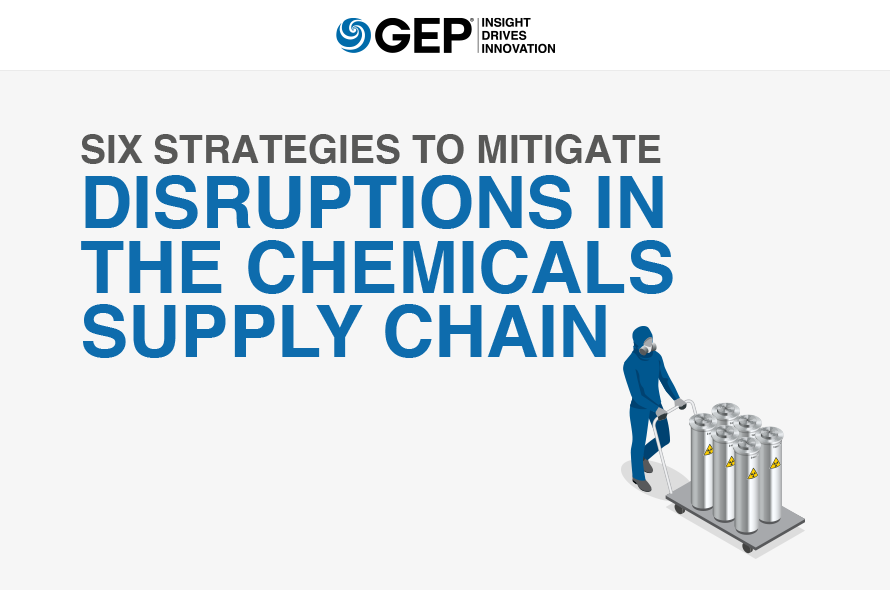You’ve spent the last few months battling disruptions caused by the pandemic. And your supply chain’s still adjusting to the new normal.
But as the dust settles, now is the time to think and plan — how can you be better prepared for future risks and disruptions?
A new GEP bulletin, Six Strategies to Mitigate Disruptions in the Chemicals Supply Chain, recommends specific steps you can take now to mitigate future supply chain shocks and improve business resilience. These proven strategies will help you respond to disruptions with greater agility and minimize their impact on your enterprise.
What’s Inside:
- Enabling faster, effective decision-making
- New way of working with your suppliers
- Changes to your sourcing and inventory processes
If you don’t want your supply chain to be in the same situation ever again — read this now.
The COVID-19 pandemic has ravaged cities and countries across the world, causing a global health crisis and disrupting supply chains across a gamut of industries. Its impact has shown us that even the best-laid plans may fall short, and that companies must develop the agility to think creatively and act quickly. Now that the immediate supply crisis has been brought under control to a degree, here are six recommendations for the chemicals and pharmaceuticals industries to plan for and prevent supply disruptions in the future.
1. Develop a Supply Chain Risk Management Plan
The current global crisis has taught us that it is imperative to have a supply risk management plan in place with appropriate people, processes, and technologies identified before disaster strikes — enterprises must ensure they are always ready with a predetermined response plan and team. The responsibilities of this team should be defined clearly so that when crisis hits, time is not wasted in detailing the plan. Importantly, this task force should be empowered to address supply-related issues quickly, regardless of the cause of disruption.
Organizations also need to establish clear processes and frameworks that can be referenced when a mitigation plan is being created, especially under a short time frame. In creating these frameworks, companies must analyze the robustness of these processes and delineate multiple responses to a range of events, in order to be well-prepared for any situation. These mitigation plans and processes must be reviewed and updated regularly to ensure they stay relevant and any new elements, based on experience and research, should be incorporated.
2. Exploit Data and Technology for Quick Decisions
For informed decision-making, robust processes need to be supplemented by comprehensive data that is accessible and parsable. Companies must regularly refresh their internal supply data, such as Bill Of Materials (BOMs), critical suppliers lists, contact information, and site inventory and tools, and these datasets must be accurate and easily accessible across the organization, in order to respond to a crisis efficiently.
The best way for the executive leadership to access this data is through user-friendly dashboards, which can be developed and deployed easily through tools such as PowerBI and Tableau. Our experience shows that mature organizations usually have an end-to-end supply chain management platform with user-friendly dashboards that provide dynamic visibility into supply risk. This will expedite decision-making, which can help an organization recover more quickly from a crisis.
3. Leverage Supplier Knowledge
It is crucial that companies identify their highest risk items and prioritize responses at the first notification of disaster itself. An effective way of building this fact base is through supplier surveys.
With inputs from relevant business stakeholders and supply chain teams, organizations can design a holistic survey that can be sent to suppliers, to understand the current risks vendors face, as well as anticipate future risks. Additionally, these surveys can be used to trace a supplier’s supply chain, which is important when the supplier is based in emerging economies in Africa and Asia, and facilitate the creation of a comprehensive risk management plan. These surveys can be modified to fit a range of events, including national disasters, cybersecurity breaches, and pandemics, across both direct and indirect categories. The supplier responses will give the organization a first-level insight into its top-priority items, and help develop an appropriate plan of action. In situations where the scope is too large to address all the issues at once, this will empower companies to make informed decisions quickly.
4. Evaluate Suppliers Through Risk Assessment Models
In addition to surveys, risk assessment models are an effective way of identifying and anticipating potential supply risks. When there’s a global-scale disaster, many companies will face financial strain, whether this is due to physical damage to plants and equipment, or rise in prices due to market shortages, or high transportation and logistics costs.
Take precautionary steps, such as running key suppliers — primarily small businesses — through bankruptcy risk models, as it will help anticipate which suppliers may be financially affected in the short term such that it may impact their ability to supply materials. A popular model is Altman’s Z-score model, which predicts a publicly traded manufacturing company’s risk of bankruptcy (or the modified Altman Z-score for privately held companies). Organizations can also run their own models in parallel, incorporating additional risk elements, and can perform a thorough analysis of each key supplier. Like surveys, these models can help anticipate supply risk and better guide a company in developing an effective risk mitigation plan.
5. Qualify and Secure Secondary Suppliers
While surveys and risk assessment models can be a good starting point, companies must always consider that there will likely be critical supply risks from primary suppliers, especially in the case of single-sourced materials. Although some suppliers may be able to alleviate the shortage independently, enterprises must look beyond their current suppliers and identify secondary sources — in case the primary supplier fails.
Professor M. Bixby Cooper of Michigan State University, a supply chain expert, compares the secondary qualification of suppliers to Minor League Baseball. In the Minor League, owners must train and develop their current roster, in addition to looking beyond their existing players to identify and pursue new talent among their Minor League affiliates. Similarly, companies must identify and qualify second-source suppliers, especially for critical products. The qualification of new suppliers in the chemicals industry is often a long, complicated and costly process. While it should ideally be completed in anticipation of a crisis, it may also be that a supplier needs to be qualified in the midst of one – this is more difficult, but reinforces the need for organizations to be agile and act swiftly and strategically in order to successfully navigate a large-scale disaster.
6. Evaluate Inventory and Inventory Management Processes
The recommendations made so far are all effective ways to steer away from potential supply risks; however, it is not until a company has the materials on site that supply risk is fully mitigated. Take the case of the recent shortage of paper and disinfectant products as a result of the pandemic — it has laid some of the shortcomings bare.
Chemical company supply chains can often be very complex, with raw materials coming in from various parts of the world, via various modes of transportation. To add to the complexity, many materials can be hazardous and require special handling.
Once there are rumblings of a crisis, companies must closely and constantly monitor their inventory levels. Through a cross-functional approach involving the plants, supply chains and other relevant stakeholders, an organization must take stock of inventory on hand so that it can estimate which materials will be affected first and must be prioritized.
While the highest-priority materials will be those with the lowest inventory and earliest stockout dates, this list should also include critical materials for the company’s highest-impact final products. Based on this assessment, a company should place additional orders for a certain subset of high-priority materials to extend its safety stock by 6-12 months.
A company should also make efforts to anticipate future market constraints, which can be done through a global supply-demand balance assessment for critical SKUs. This is very pertinent for fine chemicals and the agrochemicals sector, both of which have a limited supply base due to the patented nature of raw materials/chemical intermediates that require sophisticated technical capabilities and limits manufacturing capacity.
Should there be a sudden surge in demand for these materials, there will be a shortage for all customers, or the materials may be available only at steep prices. For example, while there is no shortage of syringes and vials now, their global demand will rise exponentially once a COVID-19 vaccine hits the market. This, in turn, will affect the supply of raw materials needed to meet the regular syringe and vial demands. So, identifying these raw materials and increasing the inventory of these SKUs would be a good strategy to prevent future shortages.
However, there are some factors to consider when increasing your safety stock, whether it’s materials identified through inventory or demand-supply assessments: short shelf life, limited warehousing capacity, and potential phase-out of the final product. While increasing inventory is an effective way to protect your business against supply risk, it must be done carefully and strategically to maximize the return on the additional cost of stocking up.
No Substitute for Planning and Preparation
The pandemic has had many companies scrambling to manage supply chain risks. The lesson to be learned here is that companies must develop robust supply chain risk management plans and prepare for potential crises. Be it forming a response team and framework, identifying top priorities and risks, qualifying new suppliers or stocking up, one thing is clear — supply risk mitigation cannot be achieved overnight. The most effective plan will be one that has been thoroughly thought out, detailed and evaluated with processes, frameworks and responsibilities in place before there is a crisis.
TURN IDEAS INTO ACTION. TALK TO GEP
GEP helps enterprise procurement and supply chain teams at hundreds of Fortune 500 and Global 2000 companies rapidly achieve more efficient, more effective operations, with greater reach, improved performance, and increased impact. To learn more about how we can help you, contact us today.
LET'S CONNECT
Samir Patel
Vice President, Consulting GEP
Samir leads GEP’s chemicals vertical. He has over 17 years of industry and consulting experience in implementing cost reduction programs for Fortune 500 clients. He has delivered significant value to clients through strategic sourcing, category strategies and best practices, M&A synergy savings, and procurement transformation, in addition to leading procurement execution and strategy for integration and divestitures.

